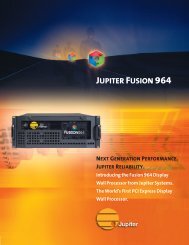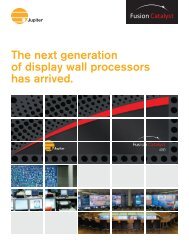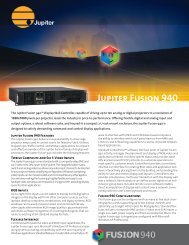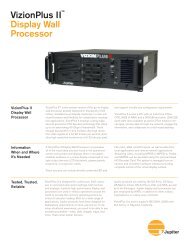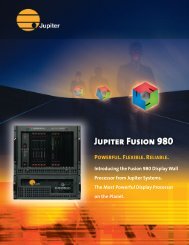New Advanced Operations Center to Serve as ... - Jupiter Systems
New Advanced Operations Center to Serve as ... - Jupiter Systems
New Advanced Operations Center to Serve as ... - Jupiter Systems
Create successful ePaper yourself
Turn your PDF publications into a flip-book with our unique Google optimized e-Paper software.
<strong>New</strong> <strong>Advanced</strong> <strong>Operations</strong> <strong>Center</strong> <strong>to</strong> <strong>Serve</strong> <strong>as</strong> Pro<strong>to</strong>type for Armed Forces<br />
_____________________________________________<br />
“The beauty of the <strong>Jupiter</strong> display wall controller is that it helps us synthesize some 18<br />
displays or any combination of them on<strong>to</strong> a single screen and see a situation more clearly,<br />
evaluate it quickly, and communicate that information more effectively <strong>to</strong> our<br />
commander.”<br />
—Major Tim Sellers, Deputy G6, 263 rd Army Air and Missile Defense Command<br />
Background<br />
The Air and Missile Defense Command and Control <strong>Systems</strong> (AMDCCS), b<strong>as</strong>ed in Huntsville,<br />
Alabama, is an office under the Project Manger for Tactical <strong>Operations</strong> <strong>Center</strong>s (PMTOC),<br />
responsible for helping the Army <strong>to</strong> defend against theater ballistic missiles.<br />
In 2001 the AMDCCS w<strong>as</strong> t<strong>as</strong>ked with providing equipment <strong>to</strong> the 263d AAMDC (Army Air and<br />
Missile Defense Command) that would serve <strong>as</strong> a pro<strong>to</strong>type for air and missile defense<br />
command and control operations around the world. In response <strong>to</strong> the events of September 11,<br />
2001, work on this pro<strong>to</strong>type w<strong>as</strong> accelerated, and the AMDCCS worked with Northrop Grumman<br />
(formerly TRW) <strong>to</strong> develop the new advanced operations center known <strong>as</strong> the AMDPCS (Air and<br />
Missile Defense Planning and Control System).<br />
State of the art<br />
The new center’s planning and control systems provide access <strong>to</strong> tactical and strategic<br />
communications, tactical data links, and intelligence networks, allowing the commander and his<br />
staff <strong>to</strong> manage all <strong>as</strong>pects of air and missile defense. Integrated with the latest in<br />
communications technologies, the system allows interoperability with joint and coalition forces.<br />
This state-of-the-art system w<strong>as</strong> developed in less than a year -- record time -- with commercial<br />
off-the-shelf equipment. Delivered <strong>to</strong> the 263 rd AAMDC, b<strong>as</strong>ed in Anderson South Carolina in the<br />
Spring of 2002, it enables the unit <strong>to</strong> deploy anywhere in the world <strong>to</strong> support theater air and<br />
missile defense missions.<br />
System Requirements<br />
Prior <strong>to</strong> installing the <strong>Jupiter</strong> controllers, the AAMDC had no way <strong>to</strong> share valuable data among<br />
different functions in their tactical operations center (TOC), except by walking over <strong>to</strong> individual<br />
consoles where one group’s information w<strong>as</strong> displayed. If a commander wanted <strong>to</strong> see an overall<br />
picture of his command, he would be forced <strong>to</strong> look at data on multiple, moni<strong>to</strong>rs in different<br />
locations within the TOC. Additionally, critical, real-time video and resources could be found in<br />
only one area of the operations center.<br />
The new display system had <strong>to</strong> address these limitations and be e<strong>as</strong>y-<strong>to</strong>-use, fault <strong>to</strong>lerant and<br />
highly reliable. Designed for 24/7 operation, it had <strong>to</strong> be rack-mounted inside a shelter or shockmounted<br />
on a military transit c<strong>as</strong>e. The system had <strong>to</strong> be able <strong>to</strong> survive harsh conditions,<br />
including dust, mud, and intense heat. Even in environmentally controlled are<strong>as</strong>, the system had<br />
<strong>to</strong> operate over a range of extreme temperatures. Most importantly, the technology had <strong>to</strong> be<br />
e<strong>as</strong>y <strong>to</strong> install, use and maintain.<br />
To accomplish its missile defense mission, the AAMDC determined <strong>to</strong> implement a full-scale<br />
display wall system. Display walls, incre<strong>as</strong>ingly used in military and other operations, provide a<br />
single integrated picture of critical information, <strong>to</strong> form a Common Operational Picture or COP.<br />
Display Wall Controllers enable display walls <strong>to</strong> synthesize and digest enormous amounts of data<br />
from a wide range of sources at the same time, <strong>to</strong> zero in on a specific spot of activity, or <strong>to</strong><br />
enlarge or manipulate the data <strong>to</strong> display only the relevant information.
<strong>Jupiter</strong> Vizion Series Display Wall Controllers<br />
Because of these requirements, the AMDCCS selected the <strong>Jupiter</strong> <strong>Systems</strong> Vizion Series<br />
controller for single, dual and quad display. The new controllers feature “virtual screen”<br />
capability, which makes multiple screens look and act <strong>as</strong> if they are a single, large screen. They<br />
provide the ideal solution for presenting large amounts of data on<strong>to</strong> an opera<strong>to</strong>r’s console or highresolution<br />
projec<strong>to</strong>r display wall quickly, simply, and reliably—and at an affordable cost.<br />
Allows Cus<strong>to</strong>mer <strong>to</strong> Choose Best Display Solution for Its Specific Needs<br />
Built for maximum flexibility and dependability, <strong>Jupiter</strong> <strong>Systems</strong>’ Display Wall Controllers are the<br />
only controllers sold on their own, independent of the projec<strong>to</strong>r. For the AMDPCS, this meant the<br />
unit could choose the best display devices for their specific needs. Moreover, the <strong>Jupiter</strong><br />
controller is well suited <strong>to</strong> a broad range of projec<strong>to</strong>rs.<br />
Provides Highest Level of Performance<br />
A primary concern of the AMDCCS w<strong>as</strong> that the controller could perform <strong>to</strong> meet the rigorous<br />
requirements of missile defense operations. By seamlessly integrating multiple sources of digital<br />
and analog information on<strong>to</strong> a single high-resolution screen, the <strong>Jupiter</strong> system enables the<br />
Army’s command and control—for the first time—<strong>to</strong> synthesize the inputs from some 19 different<br />
sources, with 24/7 reliability. The unparalleled combination of up <strong>to</strong> 12 video and 12 RGB inputs,<br />
LAN connectivity, and the ability <strong>to</strong> run all PC applications in one platform enables the visual data<br />
<strong>to</strong> be displayed in exactly the way the viewer needs it. The Vizion series supports a 16bpp color<br />
model at resolution of up <strong>to</strong> 1600 1200 for clear, sharp imaging. Sources simply plug in<strong>to</strong> rearmounted<br />
ports for a clean and e<strong>as</strong>y setup.<br />
High performance is also <strong>as</strong>sured through the use of a Pentium processor, a 7200 RPM<br />
UDMA/100 hard drive, 256MB of RAM, and a 10/100 Mbps Ethernet interface.<br />
E<strong>as</strong>y-<strong>to</strong>-Use<br />
The compact, fully integrated system is dependable and intuitively e<strong>as</strong>y <strong>to</strong> use and can be<br />
controlled by an attached keyboard and mouse, a <strong>to</strong>uch-panel interface, or a cus<strong>to</strong>mer interface.<br />
Users can also control the system remotely via a LAN and a Vizion series control client. Multiple<br />
clients can connect <strong>to</strong> the processor simultaneously, and all client users receive real-time<br />
updates. Through the e<strong>as</strong>y-<strong>to</strong>-use Windows NT/2000 interface, users can create and adjust RGB<br />
and video windows on the screen, save the current setup of the system <strong>as</strong> a layout, and recall<br />
that layout at any time. The high level of visual feedback makes control of nearly all <strong>as</strong>pects of<br />
the system simple and intuitive.<br />
Remote-Control Interface<br />
The remote-control interface, ControlPoint, provides the capability of controlling your RGB and<br />
LiveVideo windows from a single homogeneous interface that can be used both locally and<br />
remotely. The remote control capabilities of ControlPoint allow control of a display device from the<br />
desk<strong>to</strong>p or console, <strong>as</strong> well <strong>as</strong> from the display controller itself.<br />
Brief Description of the Solution<br />
The new mobile command and control system consists of six vehicles and six shelters (16 x 30<br />
feet). Three of the tents contain video walls which me<strong>as</strong>ure approximately 60” in diameter: Active<br />
Defense, P<strong>as</strong>sive Defense, and Attack <strong>Operations</strong>. A fourth, the Combat Information <strong>Center</strong>,<br />
houses two 60” displays side-by-side and can handle up <strong>to</strong> 18 different images or inputs (nine<br />
each). Each screen is designed <strong>to</strong> display individual video feeds from two Epson 9000 series<br />
projec<strong>to</strong>rs which are e<strong>as</strong>y <strong>to</strong> mount and relatively small compared <strong>to</strong> a pl<strong>as</strong>ma moni<strong>to</strong>r or large<br />
screen television. Weight is greatly reduced by using the screens and cabling is simplified by
using fiber inputs <strong>to</strong> the <strong>Jupiter</strong> controller which converts signals <strong>to</strong> the requisite RGB, and Video<br />
feeds.<br />
About <strong>Jupiter</strong> <strong>Systems</strong><br />
<strong>Jupiter</strong> <strong>Systems</strong> is considered the leading worldwide supplier of network-b<strong>as</strong>ed multiple-screen<br />
display stations and display wall controllers. Its products, considered “best of breed”, drive<br />
desk<strong>to</strong>p and opera<strong>to</strong>r consoles and projec<strong>to</strong>rs in display walls. All <strong>Jupiter</strong> products feature “virtual<br />
screen” capability, which makes multiple screens look and act <strong>as</strong> if they are a single, large<br />
screen. <strong>Jupiter</strong> <strong>Systems</strong> h<strong>as</strong> 3,000 installations around the world, in the utilities,<br />
telecommunications, aerospace and defense, corporate, manufacturing, process control, traffic,<br />
and law-enforcement markets. Its installations include the transit authorities of Bos<strong>to</strong>n,<br />
W<strong>as</strong>hing<strong>to</strong>n D.C., and Chicago; telecommunications companies such <strong>as</strong> AT&T, Sprint, Telia A.B.<br />
(Sweden), and Deutsche Telekom; and Boeing, GE, Northrop Grumman, NASA, and many other<br />
major companies throughout the world.<br />
For more detailed information on the <strong>Jupiter</strong> Vizion Series Controller, you can obtain a product<br />
specification sheet online at http://www.jupiter.com/Frame_Vizion.htm



